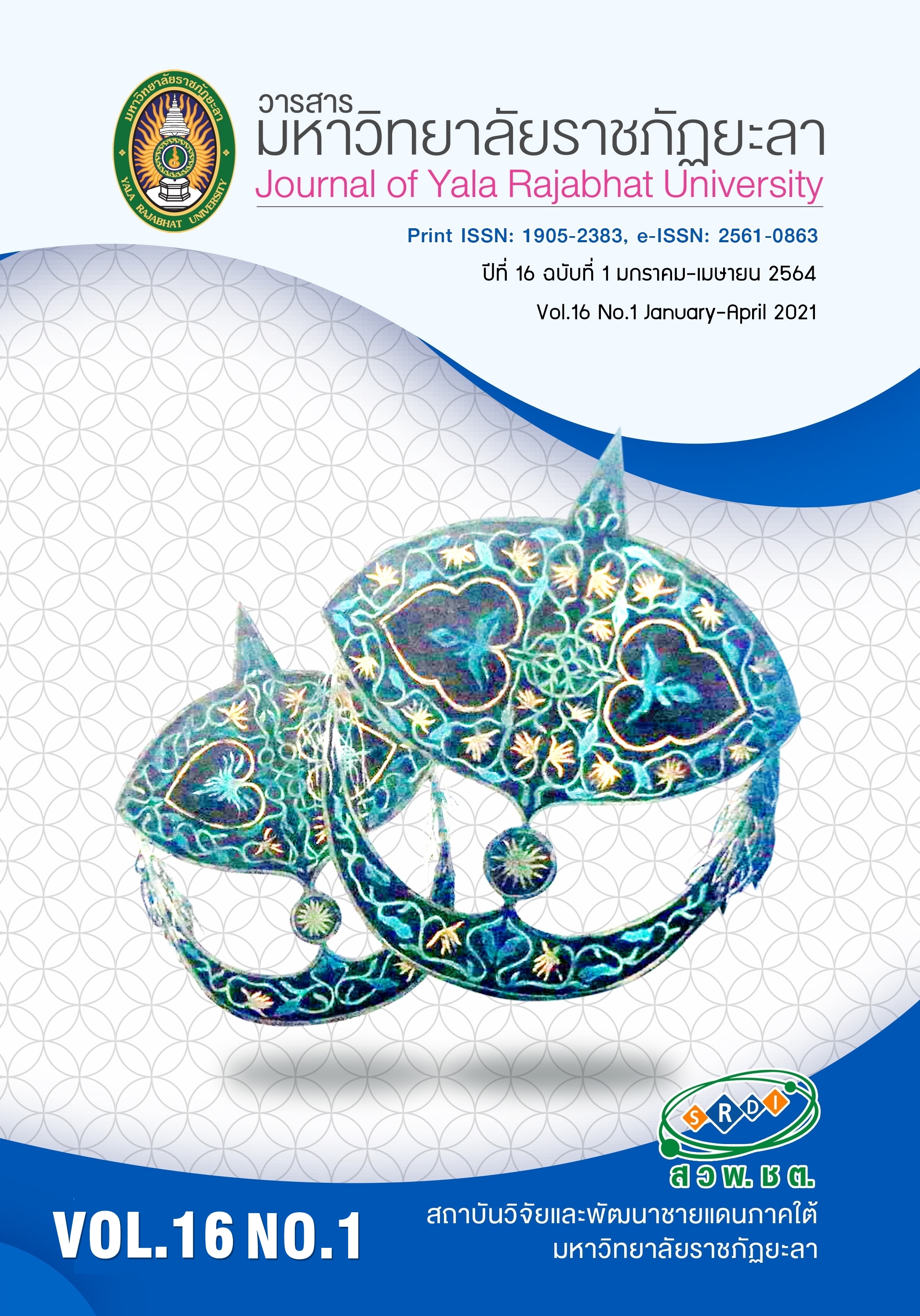ผ้าฝ้ายทอมือจอมทองกับแนวทางการสร้างมูลค่าเพิ่มเพื่อการยกระดับผลิตภัณฑ์ในตลาดสมัยใหม่ : การวิจัยเชิงคุณภาพ
Main Article Content
บทคัดย่อ
การวิจัยนี้ศึกษาความเป็นมาและสภาพการดำเนินธุรกิจผ้าฝ้ายทอมือจอมทอง จังหวัดเชียงใหม่ ค้นหาแนวทางการสร้างมูลค่าเพิ่มและการยกระดับผลิตภัณฑ์ผ้าฝ้ายทอมือฯ สู่การตลาดสมัยใหม่ และนำเสนอแนวทางการพัฒนาผ้าฝ้ายทอมือฯเพื่อเพิ่มขีดความสามารถในการแข่งขัน เป็นการวิจัยเชิงคุณภาพเก็บข้อมูลด้วยการวิจัยเอกสาร และการวิจัยภาคสนามด้วยการสัมภาษณ์เชิงลึกและการสนทนากลุ่ม ผลการวิจัยพบว่า ผู้ประกอบการส่วนใหญ่ไม่มีการจัดการระบบข้อมูลที่เป็นการเก็บรวบรวมข้อมูลความต้องการและสิ่งที่ลูกค้าให้ความสำคัญ ไม่มีการจัดกลุ่มลูกค้า ยังยึดติดในรูปแบบดั้งเดิมแบบง่าย ๆ ไม่กล้าที่จะเปลี่ยนแปลง ไม่มีการทดสอบตลาด ไม่สร้างสรรค์บรรจุภัณฑ์ที่มีความเหมาะสมกับผลิตภัณฑ์ ไม่มีการสร้างและสื่อสารถึงเอกลักษณ์ของสินค้าให้สะท้อนเรื่องราวอย่างเป็นสากล อีกทั้งยังขาดการให้ความสำคัญต่อการสร้างตราสินค้าให้ทันสมัย ในทางตรงกันข้าม การคิดค้นและสร้างสิ่งใหม่เป็นไปอย่างช้า ๆ ด้วยข้อจำกัดด้านความรู้และแหล่งทุนที่จะใช้เทคโนโลยีเข้ามาช่วยให้ความสำคัญในการดึงดูดลูกค้ามามีส่วนร่วมในกิจกรรมที่เกี่ยวข้องกับสินค้า สาเหตุเหล่านี้จึงเป็นอุปสรรคต่อการสร้างมูลค่าเพิ่มและการพัฒนาฯ ข้อเสนอแนะคือ กลุ่มผู้ประกอบการต้องรักษาภูมิปัญญาที่สืบทอดรักษามาสร้างให้เป็นอัตลักษณ์ผ่านการเรียนรู้และความเข้าใจในการเปลี่ยนแปลงที่เกิดขึ้นอย่างเป็นพลวัตนับตั้งแต่กระบวนการต้นน้ำ กลางน้ำ ไปจนถึงปลายน้ำ หน่วยงานรัฐ ต้องพิจารณาถึงการให้ความช่วยเหลือ ส่งเสริม สนับสนุน ทรัพยากรที่เกี่ยวข้องและจำเป็น โดยเฉพาะความรู้ด้านเทคโนโลยีและงบประมาณ และ โซ่อุปทานที่กลุ่มผู้ประกอบการต้องคำนึงถึง ให้สามารถทำงานสอดประสานกันได้อย่างลงตัว
Article Details
บทความ ข้อมูล เนื้อหา รูปภาพ ฯลฯ ที่ได้รับการเผยแพร่ในวารสารมหาวิทยาลัยราชภัฏยะลานี้ ถือเป็นลิขสิทธิ์ของวารสารมหาวิทยาลัยราชภัฏยะลา หากบุคคลหรือหน่วยงานใดต้องการนำทั้งหมดหรือส่วนหนึ่งส่วนใดไปเผยแพร่ต่อหรือกระทำการใดๆ จะต้องได้รับอนุญาตเป็นลายลักษณ์อักษรจากวารสารมหาวิทยาลัยราชภัฏยะลาก่อนเท่านั้น
เอกสารอ้างอิง
Chaiprakong, T. & Kornlert, P. (2018). Study and analysis of cost, volume and profit on cotton hand weaving products: A case study of Ban Nong Ab Chang Village, Sobtia Sub-District, Chom Thong District, Chiang Mai Province. Payap University Journal, 28(1), 71-83. (in Thai)
Chudhavipata, W. (2012). Textile: Reflection of Thai traditions. Research Project. Dhurakij Pundit University. (in Thai).
Clinic Technology, Rajamangala University of Technology Lanna. (2015). Project of Science and Technology Village, Crafts textile dyeing natural nano Village under the village's network of science and technology Year 2. Final Report.
Coltrain, D., Barton, D. & Boland, M. (2000). Value added: Opportunities and strategies. Department of Agricultural Economics, Kansas State University. 1-18.
Creswell, J. W., & Clark, V. L. P. (2007). Designing and conducting mixed methods research. Sage Publications, Los Angeles, London, New Delhi, Singapore, Washington DC.
De Chernatony, L., Harris, F. & Dall’Olmo Riley, F. (2000). Added value: its nature, roles and sustainability. European Journal of marketing, 34(1/2), 39-56.
Durmaz, Y. & Efendioglu, I. H. (2016). Travel from traditional marketing to digital marketing. Global Journal of Management and Business Research: E-Marketing, 16(2), 34-40.
Grace. S. T & Fridah, T. (2016). Factors affecting value addition to tea by buyers within the Kenyan tea trade value chain, International Journal of Humanities Social Sciences and Education (IJHSSE), 3(2), 133-142.
Jain E. & Yadav, A. Marketing and technology: Role of technology in modern marketing. Journal of Business and Management, 19(5), 49-53.
Khumhaeng, S., Na Pathum, S. & Laksitamas, P. (2018). The modern marketing based of new startup Thailand 4.0. Journal of Humanities and Social Sciences Thonburi University, 12(29), 45-55. (in Thai).
Kitchen, P.J. and Proctor, T. (2015). Marketing communications in a post-modern world. Journal of Business Strategy, 36(5), 34-42.
Koopoolsup, T. (2012). Productivity improvement in coconut shell product at the improvement of products made from coconut shells. Industrial Technology Lampang Rajabhat University Journal. 5(1), 49-57. (in Thai).
Michałowska, M. & Danielak, W. (2015). The impact of globalization on consumer behavior in Lubuskie Province in the light of the research. Pobrane z czasopisma Annales H – Oeconomia, 49(3), 135-146.
Pooripakdee, S. (2018). The development of knowledge for product value creation to enhance competitiveness for OTOP entrepreneurs in Phetchaburi, Prachuap Khiri Khan, Samut Songkhram and Samut Sakhon. Veridian E-Journal, Silpakorn University (Humanities, Social Sciences and arts), 11(2), 2153-2168. (in Thai).
Puangpanya, B., Kenaphoom, S. & Yupas, Y. (2016). Management approach for enhancing the cultural commodity. Bailan Journal, Ubon Ratchathani Rajabhat University, 1(1), 80-101. (in Thai).
Sampatpong, W. (2016). The integrated marketing communications strategies to creative One Tambon One Product (OTOP) brand equity of Thai silk products. VRU Research and Development Journal Humanities and Social Science, 11(2), 185-192. (in Thai).
Sombultawaee, K. (2018). The influent of values affecting brand equity perception via social media of Gen Y in Prayathai. Veridian E-Journal, Silpakorn University (Humanities, Social Sciences and arts), 11(2), 1500-1514. (in Thai).
Tancharoen, S. (2018). Quality development guidelines for OTOP product of community enterprise in Muang District, Samutsongkhram Province. Lampang Rajabhat University Journal, 7(2), 155-166. (in Thai).
Trakoolchokumnuay, T. (2015). Innovation of rice produciton, rice processing, and tice trade in Thailand. Journal of Social Development, 17(2), 51-67. (in Thai).
Walsh, M., Lynch, P. & Harrington, D. (2010). Creating superior competitive advantages for the small tourism firm through capitalizing on the firm-level dynamic capability of innovativeness. The Tourism and Hospitality Research in Ireland Conference (THRIC), 15th-17th June2010, Shannon College of Hotel Management.


